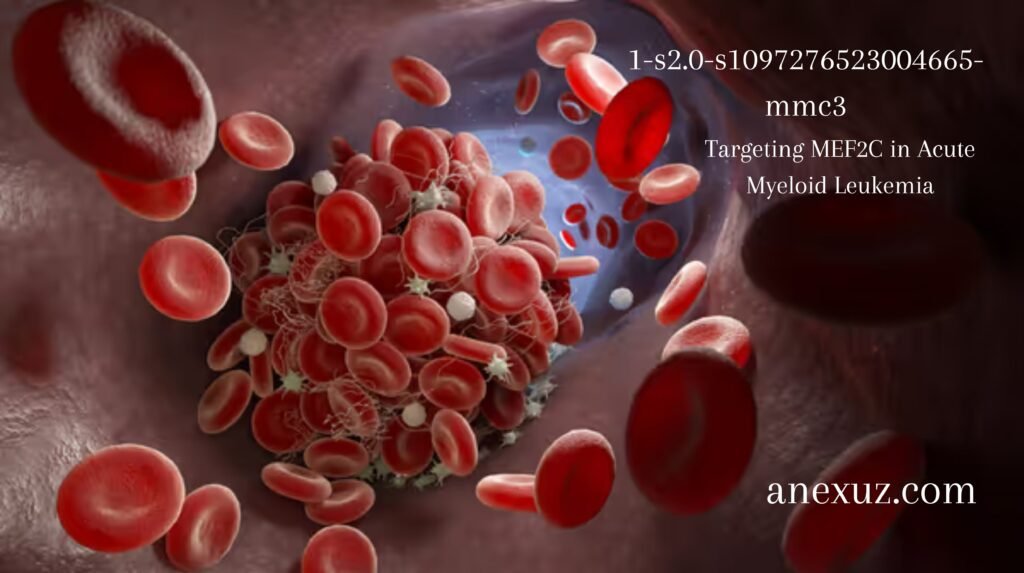Introduction
1-s2.0-s1097276523004665-mmc3 : Acute Myeloid Leukemia is one of the most aggressive and complex forms of blood cancer; it is characterized by the proliferation of white blood cells at an alarming rate.
The latest study published in Molecular Cell sheds light on important issues relating to AML with special emphasis on novel approach targeting the disease via inhibition of a transcription factor referred to as MEF2C, which has been identified as crucial for leukemia cell survival.
Using CRISPR-based screening, scientists discovered key AML cell genetic dependencies that point the way to a novel treatment mechanism.
This report discusses the relevance of MEF2C inhibition and explores how targeting SIKs offers promise for potential AML therapies.
Function of MEF2C in AML : 1-s2.0-s1097276523004665-mmc3
Myocyte Enhancer Factor 2C, or MEF2C, is a transcription factor that plays an important role in cell differentiation and function. Mef2c is usually aberrantly controlled in AML, and this results in unregulated cell proliferation and cancer.
Scientists have been unable to directly inhibit Mef2c because of the inherent intricacies of transcription factors and also because no specific inhibitors have been devised.
This is through the identification of MEF2C dependencies that afford scientists a direct route through which to indirectly inhibit MEF2C through upstream pathways.
Salt-Inducible Kinases (SIKs): Inhibiting MEF2C From the Upstream End
Hence, the study shows that MEF2C binds to a family of kinases called Salt-Inducible Kinases (SIKs), which are SIK2 and SIK3 among others.
These kinases regulate several cellular processes and, crucially for this report, help maintain the activity of MEF2C in AML cells.
Via CRISPR screens, LKB1, the kinase that activates SIKs, was identified as necessary for downstream effects that lower MEF2C activity and, consequently AML cell survival.
Perhaps one of the most interesting observations in this study is that SIK inhibition occurs through the histone inside the cells being altered.
Histones are proteins associated with packaging DNA, and DNA itself is a modified tool to control gene expression. Inside the AML cells, SIK3 phosphorylates and regulates HDAC4, which serves as a cofactor that helps MEF2C regulate gene expression.
The inhibition of SIKs reduces the acetylation of histones within the enhancers bound by MEF2C, thus removing the proliferative growth driven by MEF2C away from the leukemia cells.
CRISPR Screening and Dataset Insights : 1-s2.0-s1097276523004665-mmc3
CRISPR technology has been used for a domain-focused screen targeting with high precision particular proteins in AML cells.
In cancer research, the use of CRISPR screens is essential because it can determine the genetic dependencies – the case being kinases AML cells rely on for survival. It’s referred to as dataset 1-s2.0-s1097276523004665-mmc3.
Data regarding LKB1 and SIK dependencies in AML have been elaborated, which informs the genes necessary to retain the oncogenic function of MEF2C.
The CRISPR screen demonstrated that the tested MEF2C-dependent leukemias are sensitive to the SIK inhibitor. Future research in such SIK-targeted therapies offers opportunities, and present-day medical approaches towards MEF2C-driven AML subtypes face challenges.
Real-World Applications and Case Studies
The conclusions of the study bring great promises to the treatment of AML since the therapies used today, such as chemotherapy, often have severe side effects and are ineffective in resistant cases.
Inhibiting SIK will disrupt the targeting of MEF2C at the molecular level: it could become a new specific treatment that was considerably less damaging to other cells.
Another promising aspect of SIK inhibition is the eradication of chemoresistance. Potential treatments of patients who relapse or do not respond to standard treatments can be given by an MEF2C-directed therapeutic approach that utilizes therapeutic strategies beyond conventional drug resistance mechanisms.
Steps of Action for Future Research and Drug Development : 1-s2.0-s1097276523004665-mmc3
Development of Selective SIK Inhibitors
The development of selective SIK inhibitors is the first priority. Designing such potent molecules that target SIK2 and SIK3 allows the indirect inhibition of MEF2C without directly targeting the transcription factor.
Clinic-based studies on MEF2C-Dependent AML:
The findings warrant additional clinic-based studies including patients with MEF2C-dependent AML, especially those not responding to the current therapies.
Stage 1 clinical studies can determine the safety and dosages as well as the therapeutic efficacy in treating AML using SIK inhibitors.
Combination Therapies:
Additional research could lead to the addition of SIK inhibitors to ongoing AML therapies. Combination therapies would be less likely to relapse since the treatments striking various AML pathways at the same time would have greater therapeutic effectiveness.
Challenges and Caveats
This study offers some promising pathways, but it has several challenges to overcome to translate such findings into practical treatment.
First, transcription factors like MEF2C are extremely difficult to target precisely and SIK inhibition, though indirect, it will still have off-target effects.
Secondly, design of drugs to overcome the blood-brain barrier to reach all cancerous sites is a significant challenge.
The role of the SIKs in non-cancerous cells must also be carefully assessed since these kinases may play critical roles for normal cellular functions in numerous tissues. A treatment-based inhibition of the SIKs with minimum toxicity could potentially be valid for the therapy of AML.
Conclusion
The MEF2C dependencies thus identified by CRISPR screening represent a new frontier in the treatment of AML. Salt-Inducible Kinases SIK2 and SIK3 have now become known as potential candidates for indirect inhibition of MEF2C, which could reduce AML proliferation at cell but not with the devastating side effects accompanied by traditional treatments.
This study thus thus opens avenues for further probing targeted therapies and gives it a ground for SIK inhibitors as a mode of treatment in AML. See More…
